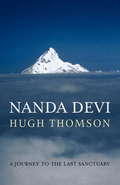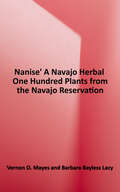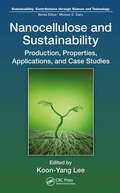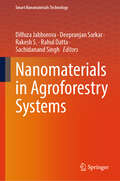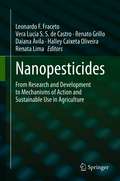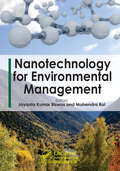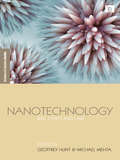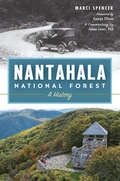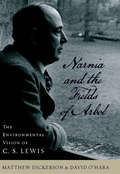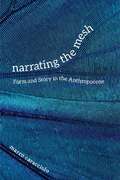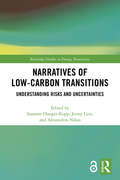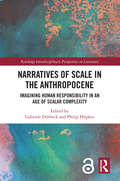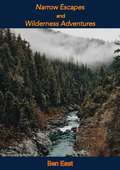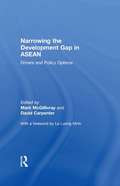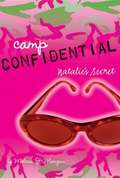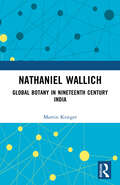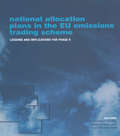- Table View
- List View
Nanda Devi: A Journey to the Last Sanctuary
by Hugh ThomsonThe story of an amazing journey to one of the remotest, most mysterious places on earthUntil 1934 the Nanda Devi Sanctuary had never been visited by human beings. Surrounded by 20,000 foot peaks which effectively seal off the mountain at their centre it is virtually impenetrable. But in 1934 Eric Shipton and Bill Tilman solved the problem in the first of their great Himalayan expeditions by forcing a way up the river gorge. The onset of war meant that the Sanctuary remained un-visited for many years and it was then closed to travellers for political reasons. After a brief period in the seventies when it was opened for expeditions the Indian Government again closed the Sanctuary.In 2000 the Sanctuary was entered for one single visit. Hugh Thomson was offered a place on this unique expedition led by Eric Shipton's son, John Shipton and the great Indian mountaineer, Colonel Kumar. This journey forms the basis of the book. Woven through it are all the amazing stories that surround the mountain - a powerful blend of myths and politics.
Naniki
by Oonya KempadooThrough luminescent light, ancestral paths, and a Caribbean spirit-inflected world, Naniki explores the musings and inner workings of the deep blue — the Caribbean Sea — and its shape-shifting sea beings.As the sea mirrors the light from the blue skies, and its depths are exposed by daggers of sunlight, so too Naniki reveals and honours the Indigenous roots of the Caribbean and its people, whose destiny is tied to the sea, the vessel of collective memory.Amana and Skelele are made of water and air, their essence intertwined with Taino and African ancestry. They evolved as elemental beings of the Anthropocene, and shape-shifting with their naniki (active spirits) or animal avatars, they begin an archipelagic journey throughout the Caribbean Basin to see the strange future they dreamed of. Until devastation erupts.Tasked by their elders to go back in time to the source of the First People’s knowledge, they must surmount historical and mythological challenges alike. How can they navigate and overcome these obstacles to regenerate themselves, their love, their islands, and their seas?A RARE MACHINES BOOK
Nanise', A Navajo Herbal: One Hundred Plants from the Navajo Reservation
by Vernon O. Mayes Barbara Bayless LacyNanise', A Navajo Herbal, co-authored by Vernon O. Mayes and Barbara Bayless Lacy, details 100 plants that are found on the Navajo Reservation, providing the reader with the Navajo name for each plant as well as ways the Navajos used them in everyday life, whether for ceremonial, medicinal or household purposes - complete with illustrations. The 100 plants are some of the most common Reservation flora of over 1,500 species of wild, vascular plants, including ferns, horsetails, conifers and flowering species and were selected by the Navajo Health Authority, Ethnobotany Project staff and approved by the Navajo Medicine Men's Association.
Nano-Structured Photovoltaics: Solar Cells in the Nanotechnology Era
by Vinod Kumar KhannaPresenting a comprehensive overview of a rapidly burgeoning field blending solar cell technology with nanotechnology, the book covers topics such as solar cell basics, nanotechnology fundamentals, nanocrystalline silicon-based solar cells, nanotextured-surface solar cells, plasmon-enhanced solar cells, optically-improved nanoengineered solar cells, dye-sensitized solar cells, 2D perovskite and 2D/3D multidimensional perovskite solar cells, carbonaceous nanomaterial-based solar cells, quantum well solar cells, nanowire solar cells and quantum dot solar cells. The book provides an in-depth and lucid presentation of the subject matter in an elegant, easy-to-understand writing style, starting from basic knowledge through principles of operation and fabrication of devices to advanced research levels encompassing the recent breakthroughs and cutting-edge innovations. It will be useful for graduate and PhD students, scientists, and engineers.
Nanocellulose and Sustainability: Production, Properties, Applications, and Case Studies (Sustainability: Contributions through Science and Technology)
by Koon-Yang LeeNanometre scale cellulose fibres, or nanocellulose, are emerging materials for various advanced applications. Nanocellulose and Sustainability: Production, Properties, Applications, and Case Studies provides a comprehensive overview of nanocellulose production, nanocellulose properties and nanocellulose in selected applications. This book serves as an entry level reference text for undergraduates, graduate students, researchers and professional engineers working in the area of nanocellulose and sustainability. Features: Summarises the surface and bulk properties of various types of nanocellulose Reviews the application of nanocellulose in water purification and optically transparent materials Provides an overview of nanocellulose as Pickering emulsifier, binder for loose natural fibres to produce non-woven preforms, as well as nanocellulose-based aerogels Presents a techno-economic analysis of industrial bacterial cellulose production Discusses the pilot scale production of cellulose nanocrystals
Nanomaterials in Agroforestry Systems (Smart Nanomaterials Technology)
by Rahul Datta Sachidanand Singh Deepranjan Sarkar Dilfuza Jabborova Rakesh S.This book presents recent trends in nanotechnology to manage agroforestry systems. A major focus has been given to green synthesis of nanoparticles, nutrient management, stress management, crop and tree production, and risk assessment for sustainable management of crops and trees using nanomaterials. The book also discusses the complex interactions of nanoparticles in agroforestry ecosystems. It provides an understanding of the nanoparticle transformation process from laboratory to field conditions that will help in technology transfer at a mass scale. Following the excellent contributions from global experts, the book will be very useful for students, scientists, conservationists, growers, and policymakers searching for the challenges and opportunities of nanotechnology in integrated farming systems.
Nanopesticides: From Research and Development to Mechanisms of Action and Sustainable Use in Agriculture
by Renato Grillo Leonardo F. Fraceto Vera Lucia S.S. de Castro Daiana Ávila Halley Caixeta Oliveira Renata LimaThis book explores the development of nanopesticides and tests of their biological activity against target organisms. It also covers the effects of nanopesticides in the aquatic and terrestrial environments, along with related subjects including fate, behaviour, mechanisms of action and toxicity. Moreover, the book discusses the potential risks of nanopesticides for non-target organisms, as well as regulatory issues and future perspectives.
Nanotechnology for Environmental Management
by Mahendra Rai Jayanta Kumar Biswas"Nanotechnology for Environmental Management" is your gateway to the latest advancements in environmental science and technology. Edited by leading international scientists, this book delves into the diverse approaches and applications of nanomaterials and nanotechnologies, offering insights into their potential for environmental remediation, energy management, and sustainable development. Each chapter showcases cutting-edge innovations, making this book an essential reference for students, researchers, scientists, technicians, and professionals in environmental management and regulation.Explore the promises and challenges of nanotechnology in addressing environmental issues, and gain valuable perspectives on the future of sustainable development. With its thorough examination of state-of-the-art nanotechnological solutions, "Nanotechnology for Environmental Management" is your indispensable guide to navigating the complexities of environmental science and technology.
Nanotechnology: Risk, Ethics and Law
by Geoffrey Hunt Michael D. MehtaNanotechnology - technology at the molecular level - is held out by many as the Holy Grail for creating a trillion dollar economy and solving problems from curing cancer to reprocessing waste into products and building superfast computers. Yet, as with GMOs, many view nanotech as a high risk genie in a bottle that once uncorked has the potential to cause unpredictable, perhaps irreversible, environmental and public health disasters. With the race to bring products to market, there is pressing need to take stock of the situation and to have a full public debate about this new technological frontier. Including contributions by renowned figures such as Roland Clift, K. Eric Drexler and Arpad Pusztai, this is the first global overview of the state of nanotech and society in Europe, the USA, Japan and Canada, examining the ethics, the environmental and public health risks, and the governance and regulation of this most promising, and potentially most dangerous, of all technologies.
Nantahala National Forest: A History (Natural History)
by George Ellison Marci Spencer James LewisCreated in 1920, the 500,000-acre Nantahala National Forest dominates the rugged southwestern corner of North Carolina. Rivers such as the Cheoah, Cullasaja, Chattooga, Nantahala and Tuckasegee carve deep gorges, making the region one of the wettest in the nation. The Whitewater River tumbles over the highest waterfall in the eastern United States. Power companies dammed local rivers, creating some of North Carolina’s most scenic recreational mountain lakes. The high peaks, secluded coves and forested woodlands of the Joyce Kilmer Memorial Forest, Panthertown Valley and Buck Creek Serpentine Pine Barrens and other areas hold cultural and natural history secrets. Author and naturalist Marci Spencer reveals the history and splendor of the Nantahala National Forest.
Naomi Knows It's Springtime
by Virginia L. KrollIt's springtime. Naomi knows the season has arrived by hearing its familiar sounds and savoring its tastes and smells. The squeaks of newborn nestlings, the sweetness of chocolate custard, the perfume of lilies and lilacs that grow in her yard all serve as gentle hints that winter has finally faded away. But can this vibrant young blind girl experience all that spring has to offer?
Napoleon's Run: An epic naval adventure of espionage and action (William John Hazzard series)
by Jonathan SpencerBetter than Sharpe... Napoleon’s Run deserves to be a runaway success’Ben Kane, Sunday Times bestselling author of LionheartOne man against an armadaLondon, 1798. Late one night, a junior naval officer at the Admiralty intercepts a coded despatch, marked with blood: Napoleon Bonaparte is about to launch the largest invasion fleet in history. Target: unknown.England is vulnerable, bereft of allies, and the Sea Lords fear a direct assault on Britain. Admiralty Intelligence sounds the alarm and prepares to unleash Nelson and the Mediterranean squadron.But before they can, they need vital information. They need a special officer to infiltrate by land or by sea to uncover the destination of Napoleon’s armada – a man who never stops.Marine Lt William John Hazzard.But will he agree to help them?Betrayed by the Admiralty at the African Cape three years earlier, Hazzard has vowed never to trust them again. Bitter memories poisoned his return home, and his devoted fiancée Sarah, unable to bear his pain any longer, disappears in Naples – never to be seen again.But the Admiralty knows just how to get him back.They know where Sarah is, and her life is in danger…From pitched sea-battles to back-street duels in a covert war, this is the epic adventure of the new hero of Napoleonic fiction: Hazzard. Perfect for fans of Seth Hunter, Bernard Cornwell and C. S. Forester.Never give up the boat.Praise for Napoleon's Run‘This is an outstanding novel, made even more remarkable by its début status. I loved it, from the first page to the end. Better than Sharpe, gripping and intense, Napoleon’s Run deserves to be a runaway success’ Ben Kane, Sunday Times bestselling author of Lionheart'Hornblower meets Mission: Impossible. A thrilling, page-turning debut packed with rousing, rip-roaring action' J. D. Davies, author of the Matthew Quinton Journals'This book has it all. Combines great action with really good history, and an engaging and original character in Marine officer William Hazzard, who adds a satisfying dash of the swashbuckling Bombay Buccaneers to some solid scholarship. In many ways this captures the true – and surprisingly subversive nature – of early British imperialism' Seth Hunter, author of the Nathan Peake novels'Outstanding... Packed to the gunwales with action, this fast-paced story introduces us to William Hazzard, a Marine Lieutenant who takes on not just Napoleon, but also the espionage and machinations of the new French Republic during the reign of terror, Neapolitan high society, and even the British Admiralty itself. Leading a crew of wonderfully-drawn characters, Hazzard is not only a convincing action hero, but also one who offers a timeless insight into loyalty, trust and honesty. A thumping read' Chris Lloyd, author of The Unwanted Dead‘This book has a rich cast of characters who will delight, enthral and keep you turning the pages to the very end. A brilliant, thrilling read, with a new – and very believable – hero. This is my favourite historical novel of the year so far’ Michael Jecks, author of the Last Templar Mysteries'A strong, fast-moving story by an author with a deep knowledge of the period and the narrative skill of a fine story-teller' Andrew Swanston, author of Waterloo'A great read! Well-tempered and well-researched, with well-drawn characters who will, I am sure, be with us for a while' Rob Low, author of The Lion Wakes'Loads of action and plenty of plot twists, meticulously researched with a fine period feel' A.J. MacKenzie, author of The Ballad of John MacLea
Narcotics: Nature's Dangerous Gifts
by Norman TaylorInformation on marijuana, opium, morphine, heroin, coca, cocaine, alcohol, tobacco, ololiuqui, peyotl (mescaline), pituri, fly agaric, caapi, kava, betel, coffee, chocolate and tea.
Narnia and the Fields of Arbol: The Environmental Vision of C.S. Lewis (Culture of the Land #Cull)
by Matthew Dickerson David O'HaraAn exploration of the Chronicles of Narnia and the Space Trilogy that &“enriches our understanding of how to care for our world&” (Alan Jacobs, author of Breaking Bread with the Dead). In Narnia and the Fields of Arbol: The Environmental Vision of C. S. Lewis, authors Matthew Dickerson and David O&’Hara illuminate an important yet overlooked aspect of the author&’s visionary work. They go beyond traditional theological discussions of Lewis&’s writing to investigate themes of sustainability, stewardship of natural resources, and humanity&’s relationship to wilderness. The authors examine the environmental and ecological underpinnings of Lewis&’s work by exploring his best-known works of fantasy, including the seven books of the Chronicles of Narnia and the three novels collectively referred to as the Space Trilogy. Taken together, these works reveal Lewis&’s enduring environmental concerns, and Dickerson and O&’Hara offer a new understanding of his pioneering style of fiction. Narnia and the Fields of Arbol, the first book-length work on the subject, finds the author&’s legacy to have as much in common with the agrarian environmentalism of Wendell Berry as it does with the fantasy of J. R. R. Tolkien. In an era of increasing concern about deforestation, climate change, and other environmental issues, Lewis&’s work remains as pertinent as ever. The widespread adaption of his work in film lends credence to the author&’s staying power as an influential voice in both fantastical fiction and environmental literature. With Narnia and the Fields of Arbol, Dickerson and O'Hara have written a timely work of scholarship that offers a fresh perspective on one of the most celebrated authors in literary history. &“Both revelatory and a pleasure to read.&” —Robert Siegel, award-winning author of The Whalesong Trilogy
Narrating Death: The Limit of Literature
by Daniel K. Jernigan Walter Wadiak Michelle WangDrawing on literary and visual texts spanning from the twelfth century to the present, this volume of essays explores what happens when narratives try to push the boundaries of what can be said about death.
Narrating the Mesh: Form and Story in the Anthropocene (Under the Sign of Nature)
by Marco CaraccioloA hierarchical model of human societies’ relations with the natural world is at the root of today’s climate crisis; Narrating the Mesh contends that narrative form is instrumental in countering this ideology. Drawing inspiration from Timothy Morton’s concept of the "mesh" as a metaphor for the human-nonhuman relationship in the face of climate change, Marco Caracciolo investigates how narratives in genres such as the novel and the short story employ formal devices to effectively channel the entanglement of human communities and nonhuman phenomena.How can narrative undermine linearity in order to reject notions of unlimited technological progress and economic growth? What does it mean to say that nonhuman materials and processes—from contaminated landscapes to natural evolution—can become characters in stories? And, conversely, how can narrative trace the rising awareness of climate change in the thick of human characters’ mental activities? These are some of the questions Narrating the Mesh addresses by engaging with contemporary works by Ted Chiang, Emily St. John Mandel, Richard Powers, Jeff VanderMeer, Jeanette Winterson, and many others. Entering interdisciplinary debates on narrative and the Anthropocene, this book explores how stories can bridge the gap between scientific models of the climate and the human-scale world of everyday experience, powerfully illustrating the complexity of the ecological crisis at multiple levels.
Narratives of Low-Carbon Transitions: Understanding Risks and Uncertainties (Routledge Studies in Energy Transitions)
by Jenny Lieu Susanne Hanger-Kopp Alexandros Nikas"The Open Access version of this book, available at https://doi.org/10.4324/9780429458781, has been made available under a Creative Commons Attribution-Non Commercial-No Derivatives 4.0 license." This book examines the uncertainties underlying various strategies for a low-carbon future. Most prominently, such strategies relate to transitions in the energy sector, on both the supply and the demand side. At the same time they interact with other sectors, such as industrial production, transport, and building, and ultimately require new behaviour patterns at household and individual levels. Currently, much research is available on the effectiveness of these strategies but, in order to successfully implement comprehensive transition pathways, it is crucial not only to understand the benefits but also the risks. Filling this gap, this volume provides an interdisciplinary, conceptual framework to assess risks and uncertainties associated with low-carbon policies and applies this consistently across 11 country cases from around the world, illustrating alternative transition pathways in various contexts. The cases are presented as narratives, drawing on stakeholder-driven research efforts. They showcase diverse empirical evidence reflecting the complex challenges to and potential negative consequences of such pathways. Together, they enable the reader to draw valuable lessons on the risks and uncertainties associated with choosing the envisaged transition pathways, as well as ways to manage the implementation of these pathways and ultimately enable sustainable and lasting social and environmental effects. This book will be of great interest to students, scholars, and practitioners of environmental and energy policy, low-carbon transitions, renewable energy technologies, climate change action, and sustainability in general.
Narratives of Scale in the Anthropocene: Imagining Human Responsibility in an Age of Scalar Complexity (Routledge Interdisciplinary Perspectives on Literature)
by Gabriele Dürbeck and Philip HüpkesThe Anthropocene concept draws attention to the various forms of entanglement of social, political, ecological, biological and geological processes at multiple spatial and temporal scales. The ensuing complexity and ambiguity create manifold challenges to widely established theories, methodologies, epistemologies and ontologies. The contributions to this volume engage with conceptual issues of scale in the Anthropocene with a focus on mediated representation and narrative. They are centered around the themes of scale and time, scale and the nonhuman and scale and space. The volume presents an interdisciplinary dialogue between sociology, geography, political sciences, history and literary, cultural and media studies. Together, they contribute to current debates on the (re-)imagining of forms of human responsibility that meet the challenges created by humanity entering an age of scalar complexity.
Narratives of Scale in the Anthropocene: Imagining Human Responsibility in an Age of Scalar Complexity (Routledge Interdisciplinary Perspectives on Literature)
by Gabriele Dürbeck and Philip HüpkesThe Anthropocene concept draws attention to the various forms of entanglement of social, political, ecological, biological and geological processes at multiple spatial and temporal scales. The ensuing complexity and ambiguity create manifold challenges to widely established theories, methodologies, epistemologies and ontologies. The contributions to this volume engage with conceptual issues of scale in the Anthropocene with a focus on mediated representation and narrative. They are centered around the themes of scale and time, scale and the nonhuman and scale and space. The volume presents an interdisciplinary dialogue between sociology, geography, political sciences, history and literary, cultural and media studies. Together, they contribute to current debates on the (re-)imagining of forms of human responsibility that meet the challenges created by humanity entering an age of scalar complexity.Chapter 3 of this book is freely available as a downloadable Open Access PDF under a Creative Commons Attribution-Non Commercial-No Derivatives 4.0 license available at http://www.taylorfrancis.com/books/e/9781003136989
Narrow Escapes and Wilderness Adventures
by Ben EastHere’s a powerful collection of 21 true action stories—the best of Ben East, his most exciting and inspiring narratives of narrow escape, written over the past 30 years. In each of these thrilling tales, this master outdoor writer recreates a dramatic adventure of an ordinary man, usually alone, facing and surviving a sudden threat to his life.All the stories in NARROW ESCAPES AND WILDERNESS ADVENTURES are true. Wherever possible, Ben East has personally interviewed the survivors of these ordeals. The authenticity, immediacy and color of each adventure is heightened by the wealth of detail the author has culled from local newspaper accounts, hospital records, even the correspondence about these men, written by families and friends.Each spellbinding story in NARROW ESCAPES AND WILDERNESS ADVENTURES unfolds against a great outdoors background: Alaska, Equatorial Africa, the Florida Keys, the Michigan woods and many others. In these locales, the men in Ben East’s stories battle heroically to stay alive as they find themselves hopelessly lost, stranded in sub-zero wastes, confronted by enraged beasts, or swamped by savage seas. Suspense continuously mounts as these amateur hunters and fishermen summon previously untapped wells of courage and endurance and, above all, their will to live when nature on the rampage strikes.In addition to being fascinating reading, this book is, in a real sense, an invaluable survival manual which shows how to improve the safety of your outdoor trips and how to survive dangers that cannot be foreseen.
Narrowing the Development Gap in ASEAN: Drivers and Policy Options
by David Carpenter Mark McGillivrayAn important part of the vision of the Association of Southeast Asian Nations (ASEAN) is to ensure that the benefits of development and economic integration are equitably shared by all member states and their citizens. ASEAN’s work therefore aims to narrow the development gap between ASEAN member states (Indonesia, Malaysia, the Philippines, Singapore, Thailand, Brunei Darussalam, Myanmar, Cambodia, Laos and Vietnam) and between sub-regions within ASEAN. Written by a team of internationally recognised experts in development economics, this book communicates the latest findings on narrowing the development gap in a practical, policy-relevant way, in a format that can influence decision makers within ASEAN member states and international donors. There have been significant development achievements in many ASEAN countries over the last 20 years, but the ASEAN region continues to be characterised by significant development gaps, particularly in income. Gaps in development achievement are also seen at the regional and sub-national levels. This book offers a better understanding of development gaps, as they exist in 2012, and provides important context that can inform the strategic needs of decision makers in the ASEAN region. Due to improvements in conceptualising and measuring well-being, including through the use of multidimensional indicators, this book gives policy makers and scholars in development economics, development policy and Asian studies well-grounded insights into the nature of the development gaps within and between ASEAN countries as well as high-level policy advice on those interventions that can contribute to a narrowing of the development gap.
Natalie's Secret (Summer Confidential #1)
by Melissa J. MorganSummer camp means lots of things: new friends, roommates, bug bites, bathroom duty. . . But it's also a chance to be on your own and to reinvent yourself. A shy girl can become the belle of the ball, and a jock might find new competition. Natalie, Jenna, Grace, and Alex have all found themselves at Camp Lakeview for different reasons. And each is keeping a secret. But if everyone is hiding something, how will they ever become friends? Natalie Goode is a city girl-way more interested in fresh sushi than fresh air. So she's bummed when her mother ships her off to "Camp Lake-puke" to broaden her horizons. But before long, Natalie notices there are some pretty cool girls are camp (and even some cute boys, too). If she can loosen up, she might even enjoy herself-unless the secret she's been keeping gets in her way. . .
Nathaniel Wallich: Global Botany in Nineteenth Century India
by Martin KriegerIn March 1807, Nathaniel Wallich, a young Danish surgeon left his home in Copenhagen towards India. During the troubles of the Napoleonic Wars, it was not possible to foresee, that he was to emerge as one of the most prominent nineteenth century botanists. Wallich spent most of his adulthood in India and, as the long-time superintendent of the Calcutta Botanic Garden, gained extensive expertise on Indian flora. A truly global communication network emerged from his desk facing the River Hooghly, reaching out to eminent specialists as well as amateur researchers long forgotten today. He conducted research trips to Nepal, as well as to South East Asia and may be perceived as one of the founding fathers of tea production in Assam. This book is based on the enormous correspondence of Wallich, preserved in libraries across Calcutta, London, Copenhagen, Hamburg, Munich and many other places. It aims to approach a long career marked by biographical ruptures and contradictions, but at the same time by continuity. It furthermore explains the tight links between supposedly neutral botanical studies and the emergence of British colonial power in India.
National Allocation Plans in the EU Emissions Trading Scheme: Lessons and Implications for Phase II (Climate Policy Series)
by Karsten Neuhoff Michael Grubb Regina BetzThe EU emissions trading scheme is the largest emissions control scheme in the world, capping almost half of European CO2 emissions. As the scheme emerges from its pilot phase, this special issue of Climate Policy journal analyses the lessons learned from the last two years and their implications for phase II. The volume presents some of the key analyses that helped inform the European Commission's decisions on national allocation plans, with research ranging from detailed country-by-country comparisons to more generic analysis that puts forward the case for harmonization. Challenging calls to seperate electricity from other sectors, a macroeconomic study suggests that the biggest efficiency gains come from inter-sectoral trading, even more than international trading. Empirical papers, which look at the expected scarcity of allowances in the market and merge models for the power and non-power sectors to project emissions and contrast these to the aggregate allocation volume, are complemented by two numerical simulations of trade and distributional effects, estimating the efficiency gains of the EU ETS in phase I and assessing allocation and distribution effects in the RGGI context.

